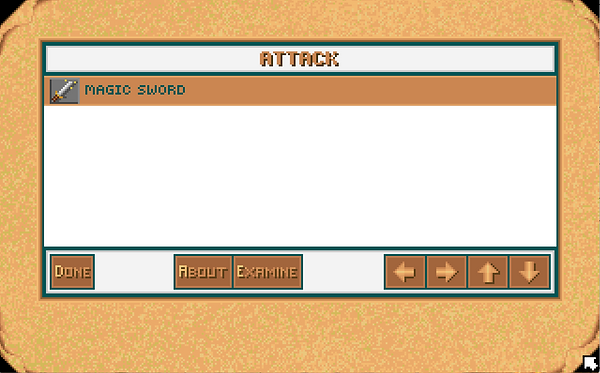The Spells of SpellCraft
It should come as no surprise that the main aspect of SpellCraft is using magic. In SpellCraft, this is done by combining Aspects, Components, and Magic Words to create spells in six different categories: Attack, Defense, Personal Modifier, Terrain Modifier, Transformation, and Conjuration.
Spells come in four levels, and can be modified after being created. However, creating them is a very specific process, and messing it up can result in very real, very painful, death.
- Attack Spells are ones that cause direct damage to enemies and wizards. Some enemies, like Illusions, are immune to physical damage spells, like Magic Sword, however.
- Defense Spells attempt to protect you from enemies by putting up barriers, walls, or webs. There is also one, Dispell, that removes enemy spells.
- Personal Modifier Spells are the ones that heal you, allow you to fly, breathe underwater, teleport, and many other things. By far, Personal Modifiers are among the most powerful in the game.
- Transformation Spells alter enemies by turning them into toads, taking control of them, or banishing them from the world completely.
- Terrain Modifier Spells alter the rules of the domains of magic. Some create or remove lakes, others reverse gravity, create snowstorms, or create sunlight.
- Conjuration Spells summon creatures to fight by your side. Orcs, Illusions, even Demons appear out of thin air to kill your enemies.
The manual that comes with the game is invaluable when it comes to figuring out the correct combinations of Aspects and Components to craft spells. If you do not have it, download it as soon as you can (or scroll down on this page to see them. Which means there are major spoilers ahead).

Note that to create a spell from an elemental college (not Mind or Ether) that is not yours, you need to add an extra Aspect. So if your college of magic is Earth, level 1 Earth spells require 1 Aspect. But level 1 Air, Water, or Fire spells will require 2 Aspects.
When you successfully create a spell for the first time, you will get a message like the one above. There will be a brief description of the spell, the domains that it can be used in (some spells can't be used in some domains), and the Elasticity of the four Components.
Spells can Increased and Modified by going to your Spellbook. It is just above the crafting section of the alchemy table. Simply go to your Spellbook, then select a spell. Spells are organized by their type, not their college. You must have enough ingredients on hand in order to increase how many copies of the spell you have. The plus sign increases the number of copies (this can be done with the keyboard or with the symbol within the spell), and the Modify button deals with changing the Components to alter its properties.



The Elasticity of a Component is how many more of that Component could be added to the spell in order to improve it. The levels of Elasticity are: Limited, Average, Good, and Excellent.
Limited: 5 or fewer of the Component can be added
Average: 6-8 of the Component can be added
Good: 9-10
Excellent: 11 or more
Extra Candles increases a spell's chance of striking a target and doing damage, but lowers its speed.
Extra Jewels increase a spell's movement rate, how far away from you the spell can be cast, and the intelligence of your spells (allowing them to pathfind around objects, for instance). Nothing gets decreased when Jewels are added.
Extra Powders increase the duration of a spell, but lowers its attack.
Extra Stones increase the durability of a spell, but lower its duration.
The total Elasticity of each spell is in RED in the list below. If a spell has an Elasticity with two numbers in it, the first number is how many of that Component can be in the spell at its lowest level (level 1 for Magic Sword, for instance), and the second number is how many of that Component can be put in at level 4. Do note: The numbers in RED are not how many can be added to a spell, but instead show the maximum number of each Component the spell will take. Magic Sword can have 12 total Candles, not 15 (3+12).
In addition to adding Components to a spell, spells can be Modified by using the next level of magic word on it. So, a level 1 spell can become more powerful by modifying the spell, and simply using a different magic word from the same college (you can't modify an Earth spell with an Air word, for instance).







In the example above, Magic Sword is given the highest modification it could get at both level 1 and level 4.
One last thing to note, however, is how spells affect you. Every time you cast a spell, you lose a small amount of your life force. The more powerful you become, the more you can cast. But, the more powerful the spell is, the more of your life force you lose when using it. So while you can create very powerful spells early on by using this guide, it does not mean you should do it, as you might kill yourself by using too much magic at once.
When in the spell selection in one of the magical domains, the amount of your health bar that becomes highlighted when you hover over a spell show how much of your life you'll lose if you use it.
In the following list of spells, any spell that has two asterisks next to it can only be created by a disciple of that college. (so a spell that says Earth** can only be created by Earth College wizards). There is one exception: Due to a glitch in the programing, anyone can create the Water College spell, Thunderstorm.







